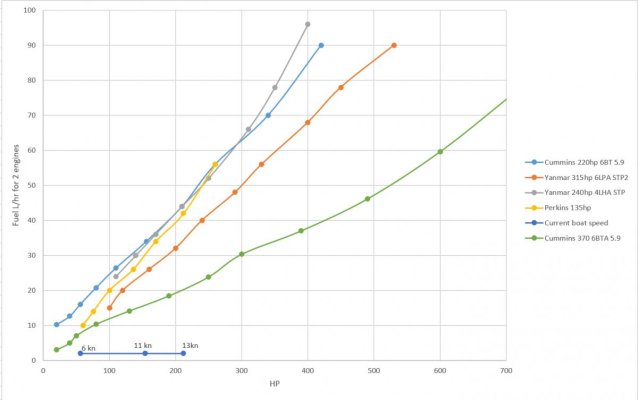Re-Power - more then doubling the power - couple points you may be over looking
Many consideration that need discussion.
Are you looking at a recreational M-5 rated diesel for weekends & day trips, or an M-1 Continuous rated Diesel to take to Hawaii or Panama Canal. -- or some where in between - like an M-2 or 3 , 4 ? or ?

What do you have for transmissions, are you reusing them ? & what are they rated for as to duty cycle M-1 through M-5 ? -- your increasing power, so you may, depending on usage, need new transmissions, depending on duty cycle, because for the doubling of HP power level your talking about & depending on usage, you may exceed their rating & they will not hold up.

Your going to have to re-prop them for sure to use that power as well & with more than doubling of the HP to 300, new bigger shafts will be needed, mark my words.
I think the Caterpillar brand might be to expensive. But some times a deal comes along with a used unit or two, that is to good to pass up. So shop around. Look on E-bay & internet.
You might look at the John Deere Marine Diesel line. They have a re-man line that is a big money saver. May need a core - so check what the core charges are, or locate a run out old 6068 core or two.

The 6068 which are a real solid power plant that would give you 300HP with turbo + after-cooler per engine with not adding a lot of weight.
I have been happy with the JD engines myself & they make a lot of different size & power combinations & different rating options. Worth looking into in my opinion. Again, what is your usage ?
I believe Mitsubishi has a full compliant new diesel that is all mechanical.
Also shopping around for what is available as either a re-man unit or a good used one of what ever brand is available that is still mechanical & low hours & priced right would also be a possible way to go. In which case - you use what is available.
Cummings has some very competitive pricing on a couple of their units, so don't forget to look their way.
BUT do not over look your transmissions & shafts & props,

as need to match what your intended usage will be & what the duty cycle that goes with that intended usage will be & the power that feed through them or you'll have trouble real quick.

Good luck.
Alfa Mike

 .
. .
.

 as need to match what your intended usage will be & what the duty cycle that goes with that intended usage will be & the power that feed through them or you'll have trouble real quick.
as need to match what your intended usage will be & what the duty cycle that goes with that intended usage will be & the power that feed through them or you'll have trouble real quick. 

 , what's the difference between the 12V and 24V cummins (apart from the number of valves
, what's the difference between the 12V and 24V cummins (apart from the number of valves  !)
!) .
.

 , and then when nothing else was available, a combination of tealeaves and rubbings cats against balloons (no reason, just fun
, and then when nothing else was available, a combination of tealeaves and rubbings cats against balloons (no reason, just fun 
